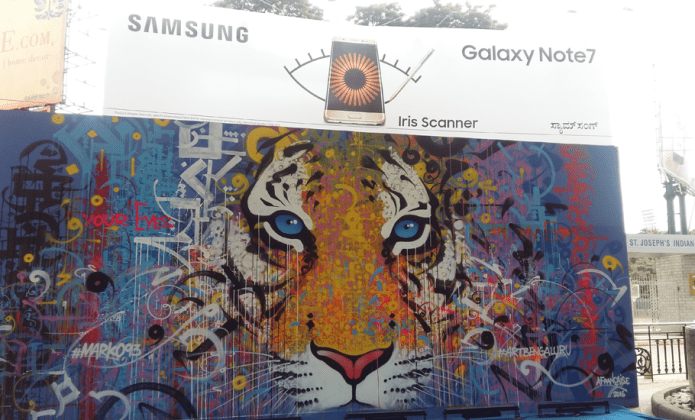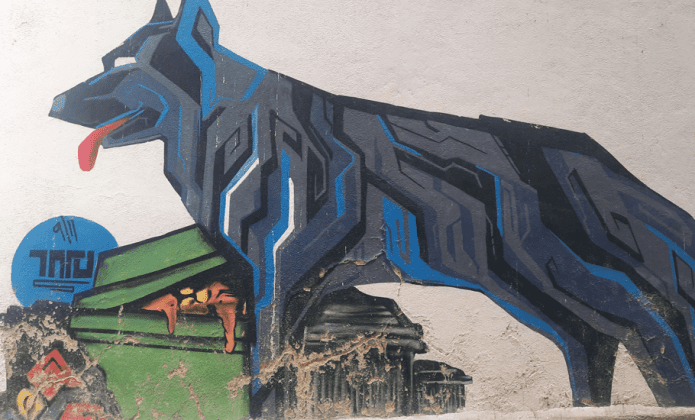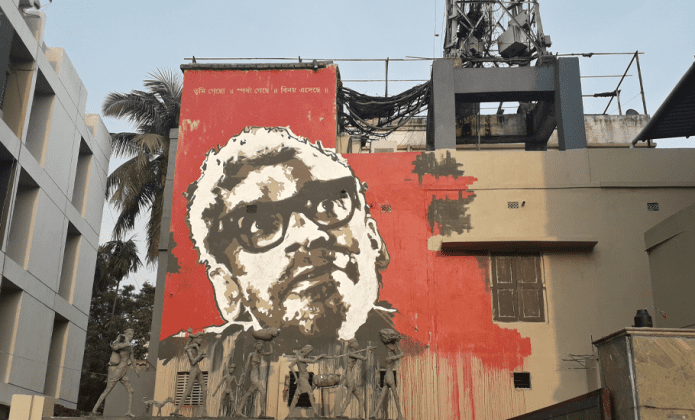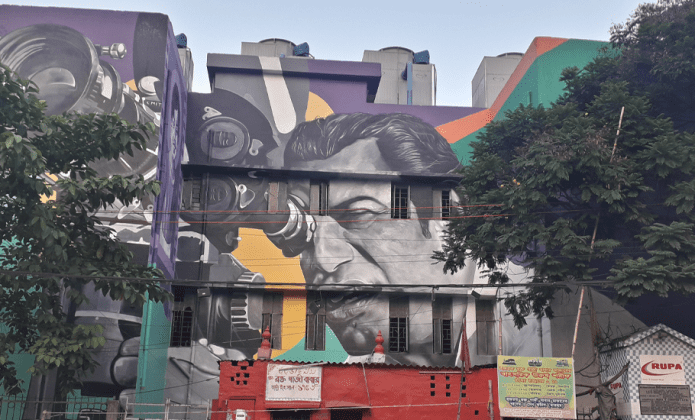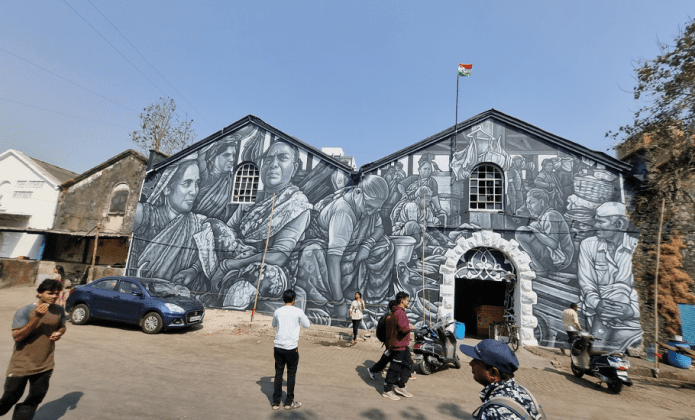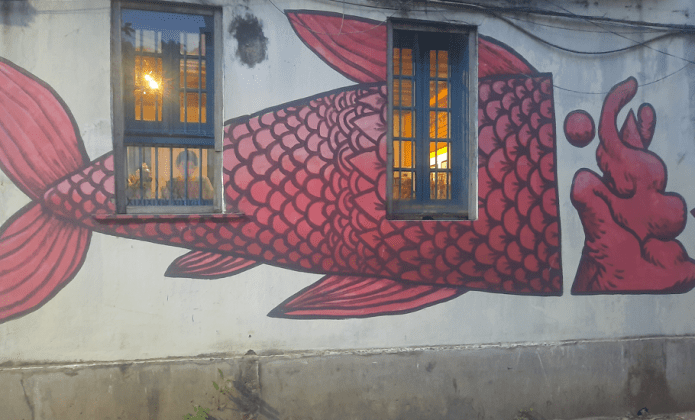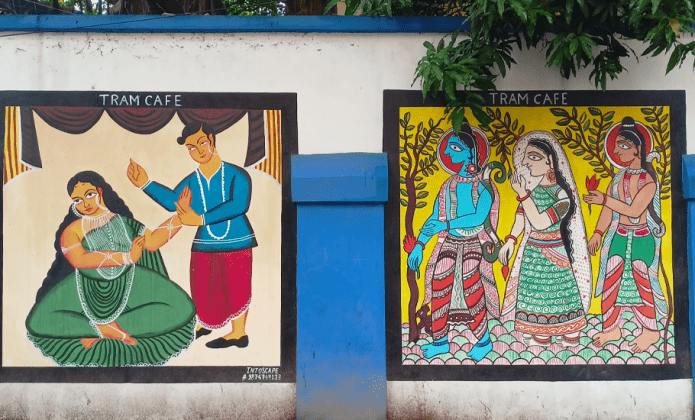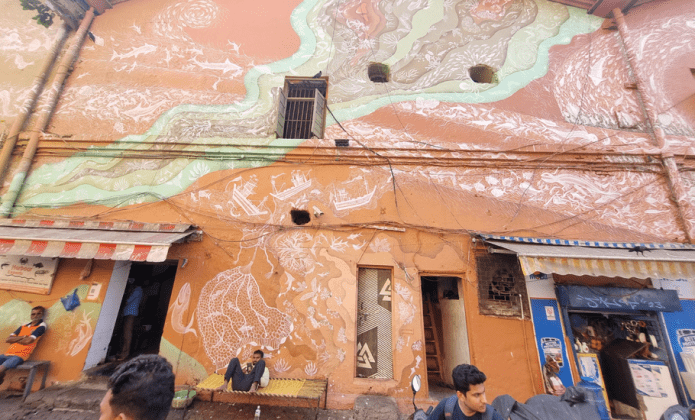
- Home
- India
- World
- Premium
- THE FEDERAL SPECIAL
- Analysis
- States
- Perspective
- Videos
- Sports
- Education
- Entertainment
- Elections
- Features
- Health
- Business
- Series
- In memoriam: Sheikh Mujibur Rahman
- Bishnoi's Men
- NEET TANGLE
- Economy Series
- Earth Day
- Kashmir’s Frozen Turbulence
- India@75
- The legend of Ramjanmabhoomi
- Liberalisation@30
- How to tame a dragon
- Celebrating biodiversity
- Farm Matters
- 50 days of solitude
- Bringing Migrants Home
- Budget 2020
- Jharkhand Votes
- The Federal Investigates
- The Federal Impact
- Vanishing Sand
- Gandhi @ 150
- Andhra Today
- Field report
- Operation Gulmarg
- Pandemic @1 Mn in India
- The Federal Year-End
- The Zero Year
- Science
- Brand studio
- Newsletter
- Elections 2024
- Events
- Home
- IndiaIndia
- World
- Analysis
- StatesStates
- PerspectivePerspective
- VideosVideos
- Sports
- Education
- Entertainment
- ElectionsElections
- Features
- Health
- BusinessBusiness
- Premium
- Loading...
Premium - Events
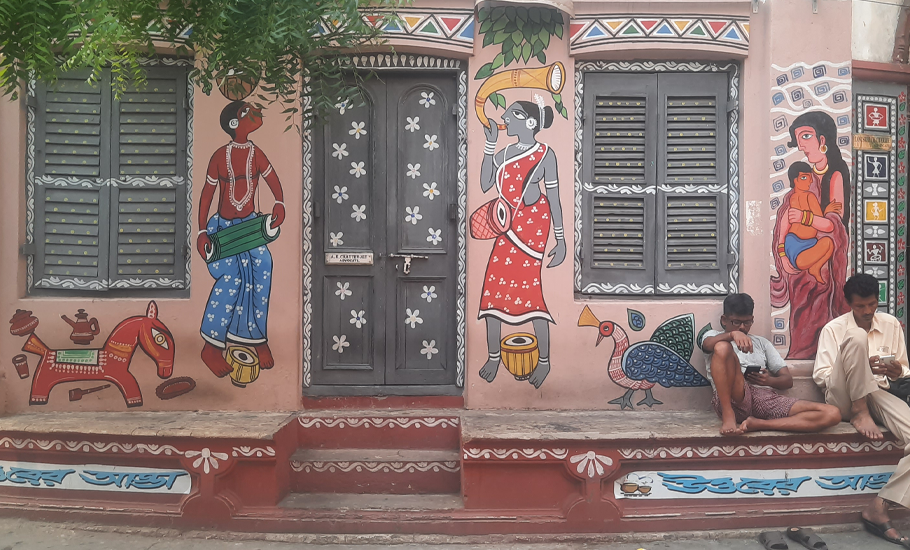
Mumbai, Bengaluru, Kolkata: What the murals say about the cities

All cities are made of people and yet each city sports a distinct scent and character, inviting its visitors on a journey of explorations. This exploration can feel like dream-walking into the possibilities of knowing the ‘inner self’ and the overwhelming power of the ‘human condition’ through art. In the dream city of Mumbai, while participating in the Kala Ghoda Arts Festival 2023...
All cities are made of people and yet each city sports a distinct scent and character, inviting its visitors on a journey of explorations. This exploration can feel like dream-walking into the possibilities of knowing the ‘inner self’ and the overwhelming power of the ‘human condition’ through art.
In the dream city of Mumbai, while participating in the Kala Ghoda Arts Festival 2023 with my 500-Peace Poetry Flag Installation, I had an amazing opportunity of exploring the Mumbai Urban Art Festival (MUAF) at the same time. Initiated by St+art India Foundation and supported by Asian Paints, an art initiative shaping the mural landscape of India in the recent years.
Sassoon Dock, some 2 km from Colaba, where I had shared my adventures over food and laughter with travelers in a hostel near the Bandargha, Masjid Bari lane area, the warehouses were covered in huge murals of the Koli community or the fishermen families of Mumbai.
The sea and Mumbai city which share so much together are oblivious to one another. Every time, I travelled to the scattered beaches around the city that never sleeps, foul smelling waves of garbage welcomed me.
This time, however, I was moved by the city’s artscape on the walls of Sassoon Dock. In the blinding heat, I made my way inside, towards the wet fishing harbour area, nudging through the rush, the cranes and cats feeding on fishes, colourful waving boats, the fishermen carrying crates of salt and ice bars to unload and distribute the catch of the day and the unnerving strong smell of rotting bones leading to the huge murals painted on the warehouses.
The murals had an immersive experience, infusing tangible art forms to the smell and feel of the sea. To see Paris-based artist Antonim Katre’s symmetrical drawing of a building and its dark-light corridors sprayed with orange, yellow and bright red over bold strokes of black, created an optical illusion of a building within a building for the viewers. Portraying its dark corners illuminated with lights, breaking in the soul, like ‘life’ itself, somehow moved me, as if it was touching the damp, inner corners of my heart.
Let art surprise and overwhelm your soul. Tracing the outlines of the warli fishes by Vayeda Brothers from the naked eyes and not from a zoomed lens of my phone was overwhelmingly refreshing. The detailed marine life depicted that people and the sea are linked together yet it’s choking the sustenance of one another with over consumption, exploitation and increased marine life pollution and negligence. The strong fishy stench and the sound of the waves remind the visitors that the sea is undoubtedly at the centre of an urban life.
While Paola Delphin’s black and white mural ‘Humanity’ on the local fisherwomen going about their daily tasks was remarkably strong in its simple aesthetics and spoke volumes in capturing the essence of that space. Andha Ras’s single life-size creation painted across four warehouses showed a local fisherwoman in strokes and colours of ‘the sea’ – teal, blue, turquoise, ink blue, sea green, her skin almost embedded into the sea, resting on her side and glancing at you peacefully.
The entire experience left me in a daze and I kept discovering more murals on the streets.
Like the wall paintings of Kala Ghoda, a black one by artist Arshad and a coloured cubic one in the lane inside the iconic ‘Kala Ghoda’ statue in Colaba which symbolised the celebration of art in Mumbai. Certainly, I loved savouring the pavement art displays, the baffling art installations, music, dance, literary events, theatre, the galleries, the museums and the aura of the enormous KGF celebrations. It was unbelievable to take it all in during such a short time.
On the Masjid Bander lane highway, where I was bunking in a travel hostel for the week, the warehouses were lined with flamingo murals in flight or resting, staring at the passersby in the noisy rush hours, providing comfort and joy for the day. While most walls were decked up with social messages and awareness art, I wish I could explore the untouched places in Mumbai more. But given my short stay and little knowledge about the pace of the city, I kept my yearning to go back and discover something new for another mural tour.
Bengaluru murals showcase community street culture and focus on shifting the people’s gaze on the hard realities of life
Murals are like dreamscapes yet realistic works, reflecting people’s life on the streets of any city, broadening the scope of creating awareness for political or social concerns and soul nurturing through art.

Bangalore, the city of gardens, took me by surprise. While visiting my sister every year, Bangalore has become a second home. Soaking in the cool breeze and walking one rainy afternoon on the tree laden streets of 80ft road in Indiranagar, I found a mural highlighting the weather beaten, poverty struck and economically strained Farmer’s hands, hidden in an alleyway yet quite visible. I wasn’t able to move away from the place, it was hard hitting.
Since art has always been used as a tool for resistance, here too this mural cried out for attention for the sake of humanity.
Though Bangalore’s Church Street is vibrant and sailing in high spirits, the murals really talk here. This place reminded me of Park Street in Kolkata, but it had a character of its own. Have you ever heard of light mural, a technique that involves using hand-held light sources, photography, paint and movement to shoot a specific piece of work? Well Marko Clement or Marko 93, a French graffiti artist is an expert in light painting. I was surprised to find a wolf and cat light murals on Church Street which depicted its capacity of holding on to a tiny space, even though shadowed by an iron gate on the bustling street.
On researching more, I found out that this was one of Marko’s works and coincidently I already had seen a life size Tiger light mural in Bangalore Art Festival in UV City back in 2016 by the same artist. He is someone who travels all around the world and paints pop art style light murals.
This long stretch was filled with surrealism yet abstract works from famous to anonymous artists. Known to be a cultural hub, Church Street hosts book lovers to party goers, street musicals evenings to delectable food spaces.
The entire MG Metro building was painted with girls playing hide and seek while flying in bubbled dream world and calling passersby to join their world of magic. This playful mural was painted by Harshvardhan Kadam and students of Srishti School of Design during Church Street’s makeover project. Another wall piece highlighting the simple idea of people commuting by metro, holding on to the straphangers during rush hours made me notice the ‘every day’ struggles of being a passenger in crowded cities. The circular murals on lifestyle, food, fashion, books and people engaging in merriment, celebrated the essence of the community coming together on the street itself.
Kolkata murals speak of culture, divinity, poverty and the people
When you know ‘your city’ like the back of your hand, its crevices, lanes-bylanes, the structures of crumbling old buildings, the scent of people, it does fail to move you at times, fails to remind you that ‘beauty’ can be found in the urbanised jungle too. But the beauty that is lost in conflicts often outshines in the street murals of Kolkata by the artists who are painting realities.
Discovering the zeal to explore new art spaces in the city, Kolkata, I walked in the extreme heat, dust, grim rains and stinky lanes to be surprised by the sheer randomness of art on the streets.
Patuli Mural on the Kumartuli Patuas or idol artisans of Bengal by St+art India Foundation is a whooping 72-ft tall life-size mural that left me speechless. From the ground, towering above the lined tea stalls, it doesn’t go unnoticed. It invites everyone to marvel at its detailed craftsmanship dedicated to the artisans of Kumartuli. While engrossed in carving a Durga idol out of clay, artist Afzan Pirzade from Pune assisted by Rohma and Rahul focuses on his subject, a Patua’s life-long tradition of making idols for generations. The mural inspired from the city’s tradition reflects and pays tribute to the importance of people who have been working with dedication and love for the craftsmanship for years.

Satyajit Ray’s mural by St+art India celebrated the icon’s 100 years of work near Charu Market, which stood tall on the cramped sidewalk Tollygunge Metro railway building. Graffiti Artist A-Kill based in Chennai painted the innocence of one of his celebrated characters ‘Apu’ which remains an icon till today on a corner while another portrait of Ray holding a camera on the face of the building. The portrait of Ray shaded by trees on both ends remains a sentiment for Kolkata’s people.
Art is for everyone, this is what murals convey to the city’s mixed populace.
By mixed populace I also mean the working class or daily-wage earners, who toil every day to keep the city running. The Howrah mural, opposite the Kolkata Rail Museum, highlighted their ethos and hard work. From a woman farmer carrying husk while grazing a calf, to a garbage-picker strolling on the streets; from a coolie running with luggage on the station platform to the shepherd delivering fresh milk to the city people, it covers them all. Everyone matters, everyone is part of the cycle of life.
The city’s artscape is spread out; each region has its own characteristics, motives and shape. Like the Behala Art Festival which has been curating some hard hitting murals for the past four years caught my attention. The walls in a closed lane on the entry point of Bus Stand Number 14 in Behala, sings of artists like Yue Minjun, Barbara Kruger, Amrita Sher Gill, Frida Kahlo, Sarah Lucas and Edith Dekyndt, paying reverence to their work in quirky compositions and moods for the theme this year. The flowing paper boat mural reminds one of dreamland and the simple playful imagination. While the late Film Director, Ritwik Ghatak, looked in grace on the passersby to ease their minds of conflicts through the existence of art, cinema, music, dance and all good things in life.
Using a residential building as a backdrop, the artists of the festival focus on Bangladeshi painter Zainul Abedin’s work on the Bengal Famine of 1943. These recreations shake up such emotions of death, echoing the pain of poverty-struck Bengal, reminding onlookers of the times during Covid when the poor suffered and died helplessly.
Travelling to the immersion ghats of Kolkata, one experiences a different kind of calmness seeped in the sunlit waves and people offering prayers. Passing through the Kumartuli lanes to reach Chapatalla Ghat, one of the 42 existing ghats of the city, you’ll witness the work of Patuas immersing themselves in crafting idols with such fine details that it appears the Gods and Goddess will speak to you any moment and take your suffering away. The whole year, artisans work on Goddess Durga idols along with many other deities which Bengalis welcome in their homes and padas to celebrates the Pujas.
Initiated by Syama Prasad Mookerjee Port Trust to paint the ghats of Kolkata in order to preserve its rich cultural heritage, it commissioned artist Shayan Mondal and team to paint Chapatala Ghat. The mural focused on the process of creating idols by the Patuas, from welcoming the Goddess to her immersion in Hooghly River, thus celebrating the power of Goddess Durga each year.
In the centre of the city though, an abstract red fish swims on the wall inside a quiet lane on Elgin Road signed by SBU ONE, blobbing its fins against the currents. While on the walls of Ballygunge Tram Depot, murals on Bengali babu culture and mythological folktales in Madhubani, Patachitra and Warli art forms mediate the essence of Bengals’ rich heritage.
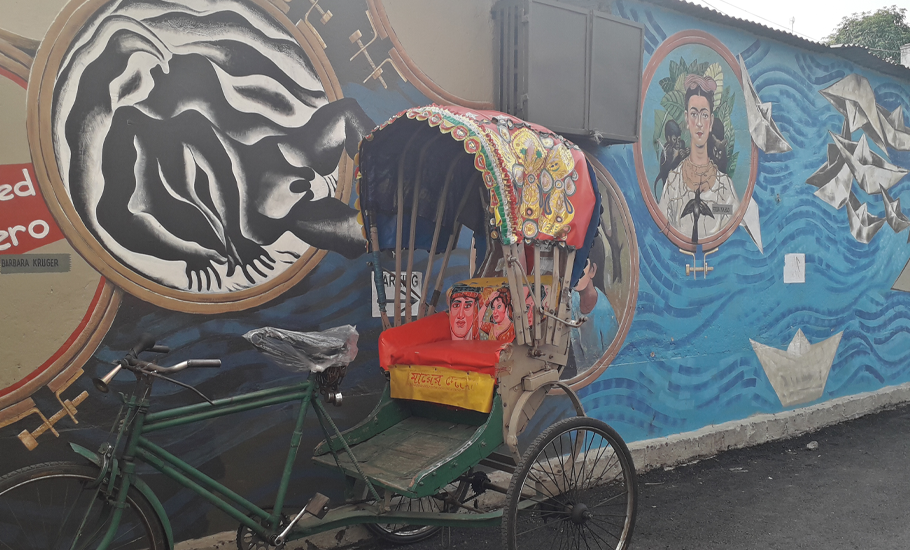
And in Uttor Padda near Deshbandhu Park in Shyambazaar, the walls are decked with Patachitra murals of women singing and dancing, boatmen stirring the boat clad with the fishes in bold stroked attires, children playing and animals enjoying the seasons in merriment.
In my search for a mural story connecting 3 cities, I got a taste of various cultures, art forms, regions and representation of people through art and its metaphorical yet moving impact on our consciousness at large.


